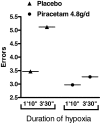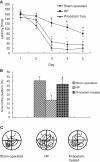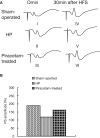Improved mitochondrial function in brain aging and Alzheimer disease - the new mechanism of action of the old metabolic enhancer piracetam
- PMID: 20877425
- PMCID: PMC2944646
- DOI: 10.3389/fnins.2010.00044
Improved mitochondrial function in brain aging and Alzheimer disease - the new mechanism of action of the old metabolic enhancer piracetam
Abstract
Piracetam, the prototype of the so-called nootropic drugs' is used since many years in different countries to treat cognitive impairment in aging and dementia. Findings that piracetam enhances fluidity of brain mitochondrial membranes led to the hypothesis that piracetam might improve mitochondrial function, e.g., might enhance ATP synthesis. This assumption has recently been supported by a number of observations showing enhanced mitochondrial membrane potential, enhanced ATP production, and reduced sensitivity for apoptosis in a variety of cell and animal models for aging and Alzheimer disease. As a specific consequence, substantial evidence for elevated neuronal plasticity as a specific effect of piracetam has emerged. Taken together, this new findings can explain many of the therapeutic effects of piracetam on cognition in aging and dementia as well as different situations of brain dysfunctions.
Keywords: aging; alzheimer's disease; mitochondrial dysfunction; oxidative stress; piracetam.
Figures







Similar articles
-
Piracetam improves mitochondrial dysfunction following oxidative stress.Br J Pharmacol. 2006 Jan;147(2):199-208. doi: 10.1038/sj.bjp.0706459. Br J Pharmacol. 2006. PMID: 16284628 Free PMC article.
-
Improvement of mitochondrial function and dynamics by the metabolic enhancer piracetam.Biochem Soc Trans. 2013 Oct;41(5):1331-4. doi: 10.1042/BST20130054. Biochem Soc Trans. 2013. PMID: 24059528
-
The metabolic enhancer piracetam ameliorates the impairment of mitochondrial function and neurite outgrowth induced by beta-amyloid peptide.Br J Pharmacol. 2010 May;160(2):246-57. doi: 10.1111/j.1476-5381.2010.00656.x. Epub 2010 Mar 9. Br J Pharmacol. 2010. PMID: 20218980 Free PMC article.
-
Piracetam: novelty in a unique mode of action.Pharmacopsychiatry. 1999 Mar;32 Suppl 1:2-9. doi: 10.1055/s-2007-979230. Pharmacopsychiatry. 1999. PMID: 10338102 Review.
-
"Brain-specific" nutrients: a memory cure?Nutrition. 2003 Nov-Dec;19(11-12):957-75. doi: 10.1016/s0899-9007(03)00024-8. Nutrition. 2003. PMID: 14624946 Review.
Cited by
-
Pharmacological Cognitive Enhancement Among International Medical Students: Assessing Study Habits as a Novel Factor.Med Sci Educ. 2024 Jul 11;34(6):1353-1360. doi: 10.1007/s40670-024-02113-w. eCollection 2024 Dec. Med Sci Educ. 2024. PMID: 39758485
-
Mitochondrial dysfunction--a pharmacological target in Alzheimer's disease.Mol Neurobiol. 2012 Aug;46(1):136-50. doi: 10.1007/s12035-012-8271-z. Epub 2012 May 3. Mol Neurobiol. 2012. PMID: 22552779 Review.
-
Astrocyte: A Foe or a Friend in Intellectual Disability-Related Diseases.Front Synaptic Neurosci. 2022 Jun 23;14:877928. doi: 10.3389/fnsyn.2022.877928. eCollection 2022. Front Synaptic Neurosci. 2022. PMID: 35812794 Free PMC article. Review.
-
Mitochondrial Metabolism-Mediated Regulation of Adult Neurogenesis.Brain Plast. 2017 Nov 9;3(1):73-87. doi: 10.3233/BPL-170044. Brain Plast. 2017. PMID: 29765861 Free PMC article. Review.
-
Diverse molecular targets for therapeutic strategies in Alzheimer's disease.J Korean Med Sci. 2014 Jul;29(7):893-902. doi: 10.3346/jkms.2014.29.7.893. Epub 2014 Jul 11. J Korean Med Sci. 2014. PMID: 25045220 Free PMC article. Review.
References
-
- Aleardi A. M., Benard G., Augereau O., Malgat M., Talbot J. C., Mazat J. P., Letellier T., Dachary-Prigent J., Solaini G. C., Rossignol R. (2005). Gradual alteration of mitochondrial structure and function by beta-amyloids: importance of membrane viscosity changes, energy deprivation, reactive oxygen species production, and cytochrome c release. J. Bioenerg. Biomembr. 37, 207–22510.1007/s10863-005-6631-3 - DOI - PubMed
LinkOut - more resources
Full Text Sources
Research Materials

